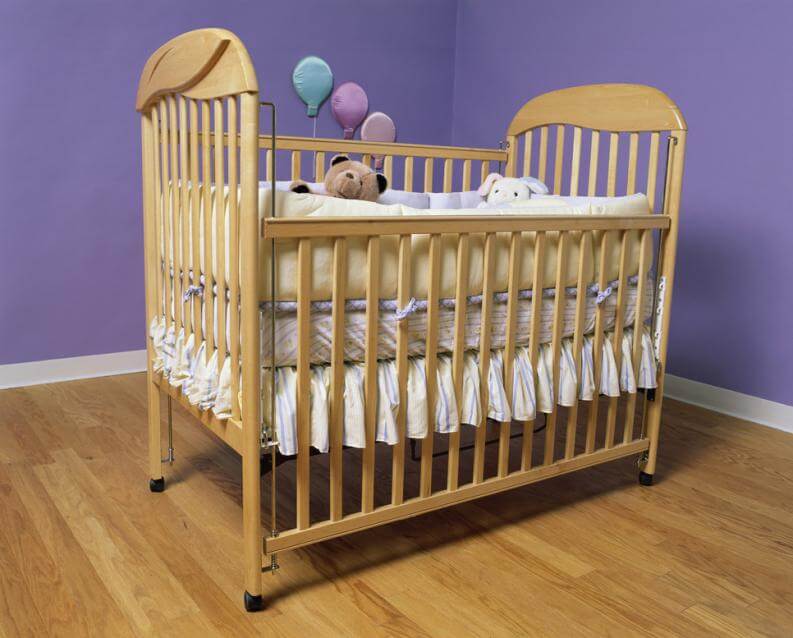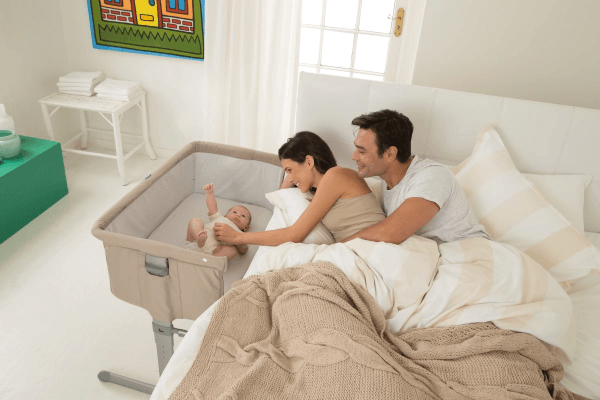5 Types of Cribs: Advantages and Disadvantages

It’s essential to choose a crib for your baby that is totally suitable for him or her. With so many types of cribs on the market this often seems so complicated and confusing.
A crib is an indispensable item that all parents must have in their homes before their baby arrives. It will be the place where the baby will sleep most of the day and night.
So, how to choose the right crib for your baby? To start with, you’ll need to have some basic notions of cribs, so that when you go to buy one, you’ll know what to look for.
It can be overwhelming looking at cribs without taking into account some basic concepts, as well as the advantages and disadvantages of each one. Don’t look any further – here’s all you need to know!
Types of cribs: advantages and disadvantages of each one
Standard baby cribs

If you close your eyes and imagine a crib, a standard baby’s crib is likely to come to mind first. These are usually cribs with four fixed sides and slats.
They come in many different styles to suit the decoration of the bedroom where the child will be.
Advantages: They are the cheapest cribs, and are easy to build and resistant.
Disadvantages: They don’t have extras like other cribs, and don’t move easily from one position to another.
Convertible or evolutionary cribs
Also known as cribs for life, convertible or evolutionary cribs are designed to grow with your baby. The logic behind the name is that these cribs can become one or more different types of furniture.
The most common conversions include:
- A standard crib
- A day bed
- A bed for children
- A single or double bed
- A small sofa
Convertible cribs are commonly described using numbers that specify the different combinations they can be transformed into.
A convertible or evolutionary crib that you can convert into all the above combinations, for example, would be referred to as a 5-in-1 convertible crib.
The good thing about this type of crib is that you save money in the long run even if the initial purchase costs more.
- Advantages: It’s cost-effective. You only need to buy one. It lasts a long time, is resistant, and there are no decorations that would make the crib obsolete.
- Disadvantages: It’s more expensive than other baby cribs. It may not fit with the future decoration of the bedroom. It’s necessary to assemble and disassemble each time the item evolves, and the crib may look outdated in future transformations.
Portable baby crib
If you don’t have much space at home, then a portable crib may be a good solution. Being able to move a crib from one room to another can make it easier for you to monitor your baby while they’re sleeping and you need to do other things.
You just have to make sure that the crib easily fits through the doors of your home. It’s a crib with wheels that will allow you to move it from one place to another (you must make sure it has a safety brake).
Portable cribs are also the cribs that have a bar that you lower, in order to be able to sleep with your baby easily and safely.
- Advantages: They’re ideal for small homes and you can monitor your baby from any room.
- Disadvantages: You must monitor your baby regularly. There aren’t many designs, and mattresses are usually the folding type.
Travel cots
Travel cots fold into a bag for easy transportation. If you need to travel with your baby, you’ll definitely need a travel cot.
Travel cradles are cheap and have lightweight materials, enabling them to be transported, assembled and disassembled with ease.
However, these types of cribs cannot be used permanently, because they aren’t suitable for long-term use for your child’s body and development, and would also wear out quickly.
Advantages: Materials, their light weight, easily assembled and disassembled, cheap.
Disadvantages: they can’t be used permanently, they wear out easily.
Multifunctional cribs

A multifunctional crib will incorporate one or more pieces of furniture into its design. The attraction of this type of crib is that you get two or more different uses out of the item, and you’ll save money and space.
A multifunctional crib, apart from being a crib, can also double as a changing table for the baby, a chest of drawers to store things, etc.
In an effort to prevent the crib from being too bulky, the attached additional items will generally be smaller than if purchased separately.
In this respect, what really matters is that the item is functional and allows you to save space and money. There are many different types of crib, so you can choose the one that best suits your room layouts and expectations.
- Advantages: You won’t need additional furniture because they’re very practical.
- Disadvantages: The additional items may be quite small, but the size of the crib will be larger than a regular one.
There are many types of existing cribs, but we’re sure that, with our advice, you’ll be able to make the best decision for you and your baby!
It’s essential to choose a crib for your baby that is totally suitable for him or her. With so many types of cribs on the market this often seems so complicated and confusing.
A crib is an indispensable item that all parents must have in their homes before their baby arrives. It will be the place where the baby will sleep most of the day and night.
So, how to choose the right crib for your baby? To start with, you’ll need to have some basic notions of cribs, so that when you go to buy one, you’ll know what to look for.
It can be overwhelming looking at cribs without taking into account some basic concepts, as well as the advantages and disadvantages of each one. Don’t look any further – here’s all you need to know!
Types of cribs: advantages and disadvantages of each one
Standard baby cribs

If you close your eyes and imagine a crib, a standard baby’s crib is likely to come to mind first. These are usually cribs with four fixed sides and slats.
They come in many different styles to suit the decoration of the bedroom where the child will be.
Advantages: They are the cheapest cribs, and are easy to build and resistant.
Disadvantages: They don’t have extras like other cribs, and don’t move easily from one position to another.
Convertible or evolutionary cribs
Also known as cribs for life, convertible or evolutionary cribs are designed to grow with your baby. The logic behind the name is that these cribs can become one or more different types of furniture.
The most common conversions include:
- A standard crib
- A day bed
- A bed for children
- A single or double bed
- A small sofa
Convertible cribs are commonly described using numbers that specify the different combinations they can be transformed into.
A convertible or evolutionary crib that you can convert into all the above combinations, for example, would be referred to as a 5-in-1 convertible crib.
The good thing about this type of crib is that you save money in the long run even if the initial purchase costs more.
- Advantages: It’s cost-effective. You only need to buy one. It lasts a long time, is resistant, and there are no decorations that would make the crib obsolete.
- Disadvantages: It’s more expensive than other baby cribs. It may not fit with the future decoration of the bedroom. It’s necessary to assemble and disassemble each time the item evolves, and the crib may look outdated in future transformations.
Portable baby crib
If you don’t have much space at home, then a portable crib may be a good solution. Being able to move a crib from one room to another can make it easier for you to monitor your baby while they’re sleeping and you need to do other things.
You just have to make sure that the crib easily fits through the doors of your home. It’s a crib with wheels that will allow you to move it from one place to another (you must make sure it has a safety brake).
Portable cribs are also the cribs that have a bar that you lower, in order to be able to sleep with your baby easily and safely.
- Advantages: They’re ideal for small homes and you can monitor your baby from any room.
- Disadvantages: You must monitor your baby regularly. There aren’t many designs, and mattresses are usually the folding type.
Travel cots
Travel cots fold into a bag for easy transportation. If you need to travel with your baby, you’ll definitely need a travel cot.
Travel cradles are cheap and have lightweight materials, enabling them to be transported, assembled and disassembled with ease.
However, these types of cribs cannot be used permanently, because they aren’t suitable for long-term use for your child’s body and development, and would also wear out quickly.
Advantages: Materials, their light weight, easily assembled and disassembled, cheap.
Disadvantages: they can’t be used permanently, they wear out easily.
Multifunctional cribs

A multifunctional crib will incorporate one or more pieces of furniture into its design. The attraction of this type of crib is that you get two or more different uses out of the item, and you’ll save money and space.
A multifunctional crib, apart from being a crib, can also double as a changing table for the baby, a chest of drawers to store things, etc.
In an effort to prevent the crib from being too bulky, the attached additional items will generally be smaller than if purchased separately.
In this respect, what really matters is that the item is functional and allows you to save space and money. There are many different types of crib, so you can choose the one that best suits your room layouts and expectations.
- Advantages: You won’t need additional furniture because they’re very practical.
- Disadvantages: The additional items may be quite small, but the size of the crib will be larger than a regular one.
There are many types of existing cribs, but we’re sure that, with our advice, you’ll be able to make the best decision for you and your baby!
This text is provided for informational purposes only and does not replace consultation with a professional. If in doubt, consult your specialist.








